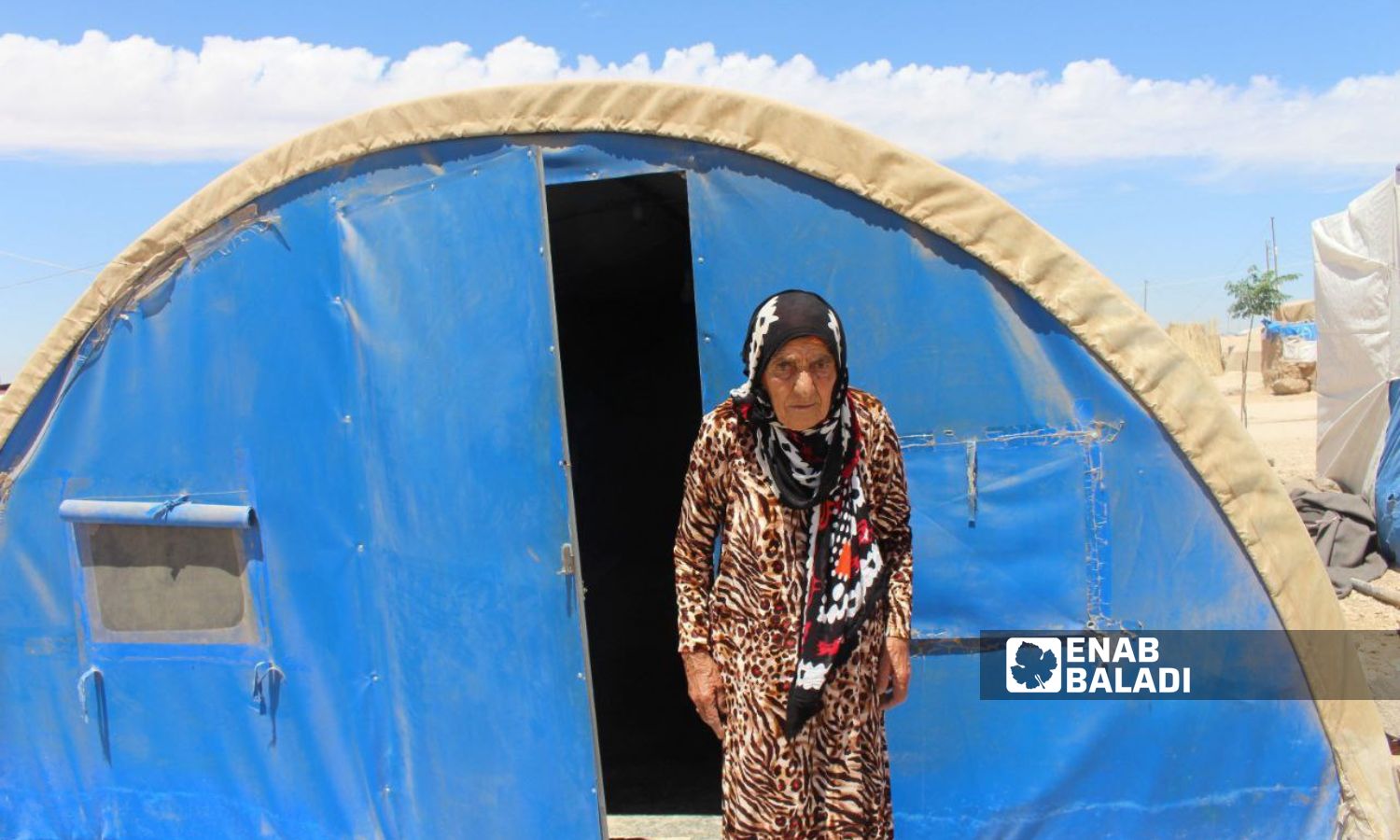



Al-Hasakah – Majd al-Salem
In the al-Tuwina (Washokani) camp, 13 kilometers northwest of al-Hasakah, thousands of displaced people live under harsh conditions, facing the sun’s heat with their fabric tents and primitive tools, amidst a lack of water and a shortage of basic resources and services.
The suffering renews each year in the camp, which is managed by the Autonomous Administration of North and East Syria (AANES) and houses 16,876 people distributed among 2,377 families, most of whom hail from the city of Ras al-Ain and its southern countryside, as well as from the town of Abu Rasin and its countryside, and villages around northern and northwestern Tal Tamr.
With evening approaching, Mohammad Hussein (49), a resident of the camp, prefers to sit with his three children outside his tent, which has turned into a “furnace,” as he describes it, due to the heat wave, similar to hundreds of other families.
He told Enab Baladi that summer in the camp is “unbearable,” with a severe water shortage, making it difficult to meet daily needs such as drinking, bathing, and cooking.
Water scarcity is one of the most critical problems faced by camp residents. With extreme heat waves and dust storms, the need for water for bathing, hygiene, and cooling becomes very urgent.
Hussein added that the price of filling a 1,000-liter tank has risen to about 40,000 Syrian pounds if a water tanker is available, noting that most tanker owners do not respond to calls due to high demand.
He mentioned that some wealthy individuals pay higher prices to tanker owners, reaching up to 100,000 pounds, especially during the Eid al-Adha period (June 16-19).
Omar al-Ali (51), another camp resident, also confirmed that water scarcity worries the residents, stating that each person’s allocation is supposed to be 40 liters of water daily for drinking, bathing, washing, cooking, and toilets.
He added that this amount might be sufficient during winter, but during summer, water becomes scarce, and demand increases.
Another issue faced by camp residents during summer is the spread of insects and rodents, amidst fears of scorpion stings with poor health services. There is only one entity providing “modest” medical care—the Red Crescent affiliated with the Autonomous Administration.
Al-Ali confirmed several cases of poisoning, sunstroke, and diarrhea among children in the camp. In many instances, residents take their children to private clinics outside the camp.
Despite having a subscription to “amperes” (private generators’ electricity) in the camp, al-Ali said many families cannot afford to pay the 14,000 pounds for one ampere subscription.
He pointed out that some families share the cost of amperes to run a refrigerator to preserve food and get cold water.
Osama al-Ali (23) told Enab Baladi that he, along with dozens of young people from the camp, goes to public pools in al-Hasakah to escape the camp’s high temperatures.
He added that he and his friends go to swimming pools in al-Hasakah at 10 in the morning and do not return until 6 in the evening, after the peak heat has subsided.
According to him, this solution also faces challenges, such as the limited number of pools in the city and some being out of service due to water scarcity. Those still operational are heavily crowded.
He noted that water in these pools is not changed frequently, making them unsanitary and potentially causing illnesses. But with the rising heat, no one focuses on cleanliness; facing the heat becomes the priority, he said.
Pool fees start from 10,000 pounds per person and can go up to 25,000 Syrian pounds depending on the pool’s quality.
The displaced in the camp experience recurring crises with changing seasons, ever since their displacement following the Peace Spring operation in 2019, carried out by the Syrian National Army backed by Turkey in Ras al-Ain, northwest of al-Hasakah, and Tal Abyad, north of Raqqa.
On June 15, Barzan Abdullah, co-chair of the Washokani camp management board, stated that with the arrival of the UNHCR and its adoption of the camp in early 2023, the World Health Organization (WHO) started its activities in the camp, receiving medical cases deemed critical or, in medical terms, “hot cases.”
He mentioned that in March, the organization informed them of its withdrawal from the camp due to “the organization’s low financial budget.”
if you think the article contain wrong information or you have additional details Send Correction